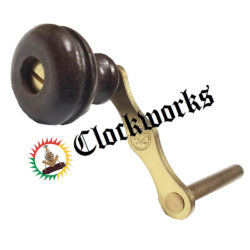How Do I Know What Size My Clock Key Is?
Understanding the correct size of your clock key is crucial for maintaining and operating your timepiece. The key size affects how well you can wind the clock and keep it running smoothly. If you're unsure about your clock key size, this guide will help you determine the right one and ensure your clock remains in good working order.
1. Why Is Knowing Your Clock Key Size Important?
Understanding the size of your clock key is essential for several reasons. First and foremost, the right key ensures that you can wind your clock efficiently. If the key is too small, it won’t grip the winding arbor correctly, making it challenging to wind the clock. Conversely, a key that is too large may slip, potentially damaging the clock’s mechanism. Therefore, knowing your clock key size prevents unnecessary wear and tear on your clock and ensures accurate winding.
2. How Are Clock Key Sizes Measured?
Clock keys are typically measured using a standardized numbering system. This system ranges from small to large, with each size corresponding to a specific measurement in millimeters. The size is determined by the diameter of the clock’s winding arbor, which is the part of the clock where the key fits. For instance, a size 6 key fits a winding arbor with a diameter of 3.75 millimeters. By measuring the arbor, you can accurately determine the correct key size.
3. What Tools Do I Need to Measure My Clock Key Size?
To measure your clock key size, you will need a few simple tools. A caliper or a precise ruler is ideal for measuring the diameter of the winding arbor. Additionally, you may use a clock key gauge, a tool designed specifically to measure clock key sizes. By using these tools, you can determine the exact size of your winding arbor, ensuring that you select the correct key.

4. Step-by-Step Guide to Measuring Your Clock Key Size
Determining your clock key size involves a straightforward process. Here’s how you can do it:
- Locate the Winding Arbor: First, identify the winding arbor on your clock. This is usually found on the clock’s face, where the key is inserted for winding.
- Measure the Arbor’s Diameter: Using a caliper, carefully measure the diameter of the arbor. Ensure the caliper is placed accurately to avoid any errors in measurement.
- Consult the Key Size Chart: Once you have the measurement, consult a clock key size chart. Match your measurement with the corresponding key size. For example, if your arbor measures 3.75 millimeters, you’ll need a size 6 key.
- Test the Key: If possible, test a key of the determined size on your clock. It should fit snugly, with no slipping or difficulty in turning.
5. What If I Don’t Have the Original Key?
If you’ve lost the original key or never had one, don’t worry. You can still find the correct size. Measure the winding arbor as described above and use the measurement to select a new key. It’s important to get the size right the first time to avoid damaging your clock.
6. Where Can I Purchase the Correct Clock Key?
Once you’ve determined the correct size, you’ll need to purchase a replacement key. At Clockworks.com, we offer a wide range of clock keys in various sizes to suit different types of clocks. Whether you need a standard size or a specialty key, you can find it in our catalog. Simply visit our website, navigate to the clock keys section, and select the size you need. We provide detailed descriptions and specifications for each key, making it easy for you to find the perfect match.

7. How Can I Ensure Longevity and Proper Maintenance of My Clock Key?
Proper maintenance of your clock key is as important as knowing its size. After every use, ensure that the key is stored in a dry place to prevent rust. Additionally, avoid using excessive force when winding your clock, as this can wear down the key and the winding arbor. Regular maintenance of both the clock and the key will ensure they last for years to come.
8. Are There Different Types of Clock Keys?
Yes, there are several types of clock keys, and each serves a different purpose. The most common are double-ended keys, which have different sizes on each end for winding and setting the time. Some clocks, especially antique ones, may require specialized keys. It’s essential to identify the type of key your clock requires before making a purchase. At Clockworks.com, we offer a variety of key types to match your specific needs.
9. What Should I Do If My Clock Key Doesn’t Fit Properly?
If you find that the key doesn’t fit properly, it could be due to several reasons. First, recheck the arbor’s diameter to ensure you’ve measured correctly. If the measurement is correct and the key still doesn’t fit, there may be an issue with the clock’s winding mechanism. In such cases, it’s best to consult with a clock repair expert. At Clockworks, we not only sell parts but also offer clock repair services. You can contact us at clockworks@clockworks.com for assistance.
10. Final Thoughts
Knowing the size of your clock key is fundamental to the proper functioning and maintenance of your timepiece. By following the steps outlined above, you can easily determine the correct key size and avoid potential damage to your clock. For a wide selection of clock keys and expert advice, visit Clockworks.com. We’re here to help you keep your clock ticking smoothly.
Updated on: 11/12/2024
Thank you!
